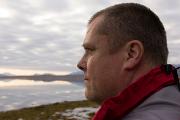Imagine this: You are a naked sea butterfly, a small sea slug living in Arctic waters. You are two centimeters long from top to bottom. Your favorite foods are smaller sea slugs and zooplankton, but you often have to survive for long periods without food. Your worst enemies are fish and seabirds.
You move up and down in the water by flapping your little “wings”. During daytime, you hide in the deep, while at night you move closer to the surface to feed, as there is less chance of being spotted and eaten by larger animals. But what happens during the polar night, that time of year when both day and night in the High Arctic are pitch black? How is your circadian rhythm then?

We will return to the sea butterfly later. First, let us find out more about marine biologist Jørgen Berge. After completing his PhD degree in 2000, Berge has participated in numerous research cruises to investigate the activity of seabirds, krill, plankton, and other marine organisms. In 2007, when Berge was employed at the University Centre in Svalbard (UNIS), he started exploring the activity of zooplankton in the Arctic during the polar night. Since then, research cruises during the dark and cold Arctic winter have been annual events for the UiT professor. What motivates him?

– I am curious to see what is inside this black box, the professor explains.
– The Arctic is changing rapidly. Faster than any other place on the globe. In the past, the sea ice was thick and the sea below was cold and dark. With less sea ice, there is more light penetrating the ocean, and we wish to investigate how this affects the ecosystem. I am grateful that I get to experience the Arctic and the changes as they happen, but at the same time, it makes me sad that my children and future generations may not experience the same frozen wilderness, says Berge.
Using both self-propelled and remote-controlled underwater robots from the NTNU scientific community, as well as cameras and divers, scientists have discovered both new species and species that were unknown to these waters. Where they expected complete darkness, there were luminescent fish and plankton. They found species that use the polar night to grow, lay eggs or prepare to spawn. The polar night is far from a resting period for marine life in the Arctic, as previously thought.
Zooplankton move up and down in the water column in a vertical migration pattern. This means that the animals swim up to the ocean surface to feed when it is dark, while hiding in the depths during lighter periods, to avoid being eaten by fish or other predators who use their sight to hunt. This process is common in oceans across the globe and is usually driven by daylight. But even during the polar night, when the sun is below the horizon all day, there will be small variations in the bakground radiation from the sun. The farther north, the less background radiation. At about 80 degrees latitude it is no longer possible for the human eye to see any difference between night and day. Still, the small change in background radiation is usually enough for zooplankton to continue to migrate in the water column, albeit only a few meters up and down in the darkest time of year. Moonlight and northern lights also affect the animals, as do lights from ships and human activity.

Photographer and filmmaker Michael O. Snyder participated in a research cruise with Jørgen in January 2018, a collaboration resulting in the documentary "Into the Dark". Snyder follows the researchers as they work in utter darkness to minimize disturbance on the measurements of how marine wildlife reacts to light. The film premiered on Tromsø International Film Festival in 2020.
See the trailer for the film here:
Jørgen Berge is no stranger to communicating research in new ways: The findings of his research group have previously resulted in the exhibition "Polar Night", which, after being shown at the Polar Museum in Tromsø, has travelled to Svalbard, Trondheim, Canada, Alaska, Washington and Russia.
– By working with reaching larger audiences with our findings, we both increase our network and gain more impact internationally, says Jørgen Berge.
Back to the story of our sea butterfly. Even though you are small and the world above is great and dark, you notice tiny changes in the light throughout the day, and you take care to feed during the darkest hours of the day. You are adapted to a life in the dark polar night as well as the bright summer, where the sun never sets. With decreasing sea ice, there has been more ship traffic – and thus more light – in your habitat. Will you be able to adapt to this new situation in the future? Adaptability is vital not only to the sea butterflies, but to the entire Arctic ecosystem.
Jørgen Berge and scientists like him need to find out how a changing climate affects our northernmost oceans. What they reveal can have an impact on how the Arctic nations manage these areas.
The researchers will not run out of work any time soon.
